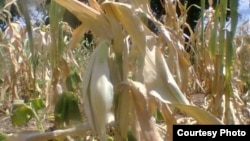The World Food Program (WFP) has warned that the whole southern African sub-region faces a possible drought.
The WFP was quoted by Reuters news agency as saying that South Africa, which produces 40 percent of the regional maize crop, would this year harvest an estimated one third of the usual output.
It said countries also facing drought include Angola, Namibia, Botswana, Lesotho, Malawi, Madagascar and Zimbabwe. It added that Zimbabwe was the worst hit.
This comes amid denials by Agriculture Minister, Joseph Made, that the situation in Zimbabwe does not warrant a declaration of a state of disaster.
Former Water Resources Minister, Sam Sipepa Nkomo of the MDC Renewal Team, told VOA Studio 7 the government should snap out of its denial mode and declare the situation a national disaster.
According to the latest Famine Early Warning Systems Network (FEWSNET) report on Zimbabwe, based on unofficial 2014/15 second round crop estimates, national projected cereal production is approximately 48 and 39 percent lower than last year and the five-year average, respectively.
“Maize production, the preferred staple by most rural households, decreased by approximately 49 percent from last year and by 32 percent from the five-year average. Based on these estimates, the country is expecting a 990,000 metric tonne cereal deficit during the 2015/16 consumption year.”
FEWSNET said most households in the cereal surplus areas in the north are currently experiencing some minimal food insecurity and this is expected to continue through September.
However, it said rural households in the south produced next to nothing this season, so they continue to rely on market purchases for their basic food needs and are currently stressed. In the absence of any assistance, households will likely be in crisis from July through September.
‘Very poor households in the south typically receive large assistance flows, however if this assistance does not occur emergency food security outcomes are expected between October 2015 and March 2016 in the southern region. Even in the presence of assistance, households would still be in crisis and stressed due to the above-average retail maize prices expected in the southern areas.”





